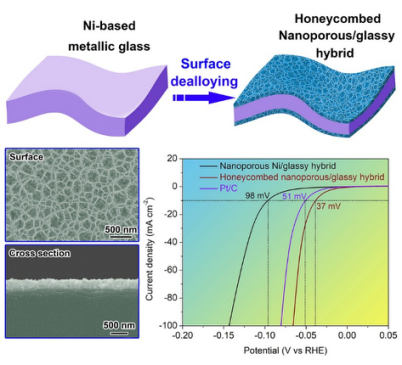Electrocatalytic water splitting for sustainable production of hydrogen has been widely regarded as one of the most promising approaches for gaining renewable and clean energy. However, it remains challenging to develop novel electrocatalysts to concurrently satisfy new hydrogen evolution reaction (HER) requirements in alkaline media, i.e., excellent electrocatalytic activity, flexible free-standing electrode structure for practical application and low-cost.
Recently, the research group headed by Prof. Zhaoping Lu from State Key Laboratory for Advanced Metals and Materials at USTB has made great progress on the functional application of metallic glasses for efficient electrochemical water splitting. They reported a state-of-the-art honeycombed nanoporous/glassy sandwich hybrid with Pt-enriched solid-solution surface layer fabricated by dealloying of Pt doped Ni-based metallic glass (MG). The fabricated hybrid can be directly served as high-performance catalytic electrode for hydrogen evolution, exhibiting superior HER performance than that of commercial Pt/C catalyst (20 wt.% Pt). Note that the MG precursor only contains 3 at.% Pt, which effectively reduces the raw cost. Moreover, the newly developed hybrid catalyst with the hierarchical configuration exhibits good flexibility due to the excellent ductility of intermediate MG matrix. The current finding not only offers a reliable strategy to develop cost effective and flexible multicomponent catalysts with low Pt usage for efficient HER, but also sheds light on understanding alloying effects of catalytic process. This work will spark rush activities on application of MGs as catalytic materials.
This work has been published in the high-profile journal Advanced Materials with a title of “Flexible honeycombed nanoporous/glassy hybrid for efficient electrocatalytic hydrogen generation” on 17 Oct. 2019 (https://onlinelibrary.wiley.com/doi/10.1002/adma.201904989). The first author is Dr. Rui Li from USTB, Prof. Xiongjun Liu and Prof. Zhaoping Lu from USTB are the corresponding authors. Another corresponding author is Prof. K. C. Chan from Hong Kong Polytechnic University. This research was supported by National Natural Science Foundation of China, Program for Changjiang Scholars and Innovative Research Team in University of China, and the project of SKLAMM-USTB.

Figure Free-standing honeycombed nanoporous/glassy sandwich hybrid catalyst with superior HER performance and excellent flexibility